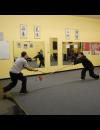Theory of Taijiquan and Health
May 20, 2024
Though the martial side of Tàijíquán is for strengthening the physical body and for defense, the scholarly side of Tàijíquán is for understanding human nature and comprehending the meaning of life. Only if (you) can cultivate these, both internally and externally, can you reach the Dào of balancing physical body and mind, and (also) the dual cultivation of human nature and physical body.
8 Min Read
The Language of Judo
May 13, 2024
Speaking Japanese is different than “speaking Judo.” But for those who want to have a better understanding and appreciation of judo, learning how to “speak Judo” opens up the whole world of judo to them.
5 Min Read
The Power of Mass Tai Chi Recitals
April 29, 2024
In honor of World Tai Chi & Qigong Day 2024, YMAA Staff Writer Gene Ching examines tai chi demonstrations done in large groups. 6 Min Read
Judo: Basics Win Matches
April 22, 2024
No one has ever walked onto a judo mat and immediately became an elite-level athlete. Anyone who thinks otherwise will have a short and limited career in judo. 6 Min Read
Five Regulators of Taijiquan
April 8, 2024
What is Tàijíquán? It is a martial Qìgōng study. Its training procedures are not different from those of other general Qìgōng (practice) and must follow the (same training) theory. These training procedures are nothing else but: regulating the body, regulating the breathing, regulating the mind, regulating the Qì, and regulating the spirit—five regulatings.
7 Min Read
The Contents of Baguazhang Training (Baguazhang - Part 2)
-
September 29, 2008
We can see from the available documents that Baguazhang covers a very wide field of training. It includes not only barehand techniques, but also many weapons.
The History of Baguazhang (Baguazhang - Part 1)
-
September 24, 2008
The martial arts history which has been passed down to us is fairly vague. In fact, it was not until this century that an effort was made to trace back this lost history.
Taijiquan Master Kao, Tao - Dr. Yang's teacher
-
September 23, 2008
Dr. Yang's first Taijiquan master, Grandmaster Kao, Tao (高濤), who Dr. Yang lost contact with after leaving for college and moving to the U.S., was finally found teaching Taiji in Taipei, Taiwan in 2008. This article is a record of that time.
Training a Sequence Efficiently
-
August 12, 2008
Over the years I have seen many people train many times a week on regular basis, yet make very little progress in their martial arts ability. They spend a lot of time practicing their sequences, yet after many months of practicing their sequences they have made very little progress.
Teaching Kids Can be Child’s Play
-
July 3, 2008
Any successful martial arts school can be enhanced through the development of a children’s program.
Teaching Kids Can be Child’s Play
-
July 3, 2008
Any successful martial arts school can be enhanced through the development of a children’s program.
Tai Chi Dynamics
-
June 25, 2008
Originally formulated in Old Chinese, the Taijiquan Classics are very compact and poetic and can be quite mysterious when translated into Modern Chinese and then into English.
Meditations on Violence
-
May 22, 2008
People are weird. They have an almost infinite ability to learn and communicate. At the same time, this amazing ability is used as much for fantasy and entertainment as it is for information and survival. Take, for example, the rhinoceros and the unicorn.
Martial Arts Conditioning and Fighting - Part 2
-
May 14, 2008
Traditional martial arts is not supposed to be glamorous, and conditioning is not a very glamorous process, being a very repetitive and monotonous type of exercise requiring many years of training.
Martial Arts Conditioning and Fighting - Part 2
-
May 14, 2008
Traditional martial arts is not supposed to be glamorous, and conditioning is not a very glamorous process, being a very repetitive and monotonous type of exercise requiring many years of training.
Martial Arts Conditioning and Fighting - Part 1
-
May 9, 2008
Through many years of history, experience, and practice, martial artists realized that in a fight, there are generally three factors that determine victory.
Martial Arts Conditioning and Fighting - Part 1
-
May 9, 2008
Through many years of history, experience, and practice, martial artists realized that in a fight, there are generally three factors that determine victory.
Generating Martial Power (Jin)
-
March 19, 2008
Jin, or Martial Power, can generally be divided into three categories: Hard Jin, Soft-Hard Jin and Soft Jin. Among these, Hard Jin uses the most muscular power, followed by Soft-Hard Jin and finally Soft Jin.
Generating Martial Power (Jin)
-
March 19, 2008
Jin, or Martial Power, can generally be divided into three categories: Hard Jin, Soft-Hard Jin and Soft Jin. Among these, Hard Jin uses the most muscular power, followed by Soft-Hard Jin and finally Soft Jin.
Taijiquan Pushing Hands
-
February 14, 2008
Almost every Chinese martial style, both external and internal, has its own hand-matching training similar to Taiji's pushing hands.
Candle Training
-
January 28, 2008
In Chinese martial society, candles were once popularly used for training. This is because candles were an important source of lighting in ancient times, and thus were more readily available for practice.
Truly Learning Chin Na
-
January 21, 2008
Though it is very hard to catch the Chin Na techniques with 100% accuracy from a book and a video, many techniques can still be learned as long as you ponder, practice, and humbly ask.
Introduction to Internal and External Jin
-
March 20, 2007
Introduction to Internal and External Jin (martial power)






















